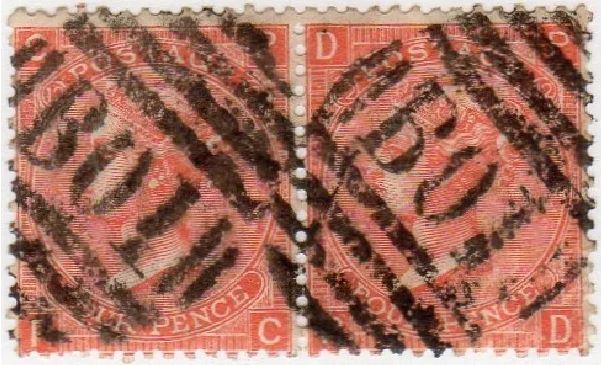cjd
Member 
Posts: 1,107 
|
Post by cjd on Jun 20, 2015 18:11:02 GMT
The B01 obliterator was assigned to British Post Offices in Egypt. Gibbons lists four types of "B01" postmarks, all of which were used in Alexandria, and one one of which was also used in Cairo. SG lists and values Great Britain stamps used in Egypt. Here is a pair of SG94, 4d vermilion, Plate 12 from 1870, struck with the Type 12 obliterator. This cancel was only used in Alexandria, according to Gibbons.  What is interesting to me is that my edition of SG lists a single SG94, Plate 12, used in Great Britain, at 50 pounds. It lists a single SG94, Plate 12, used in Alexandria, as " from 29" pounds. I would not have guessed that the 4d stamp used abroad would catalogue that much below the same example used at home. |
|
Admin
Administrator 
Posts: 2,676
|
Post by Admin on Jun 20, 2015 18:31:24 GMT
Don't make sense?
Unless more were used abroad then Home.
|
|
|
|
Post by jimjung on Jun 20, 2015 21:51:06 GMT
This stamp from British Guiana looks like a GB Postmark. Since the stamps came from GB, it seems likely that the cancelling device came with the stamps.  |
|
rod222
Member 
Posts: 11,043  What I collect: Worldwide Stamps, Ephemera and Catalogues
What I collect: Worldwide Stamps, Ephemera and Catalogues
|
Post by rod222 on Jun 20, 2015 22:25:17 GMT
This stamp from British Guiana looks like a GB Postmark. Since the stamps came from GB, it seems likely that the cancelling device came with the stamps. Obliterators A03 and A04 were allocated to Georgetown and New Amsterdam, Guyana Sometimes obliterators were re allocated to offices at home. |
|
rod222
Member 
Posts: 11,043  What I collect: Worldwide Stamps, Ephemera and Catalogues
What I collect: Worldwide Stamps, Ephemera and Catalogues
|
Post by rod222 on Jun 20, 2015 22:30:31 GMT
What is interesting to me is that my edition of SG lists a single SG94, Plate 12, used in Great Britain, at 50 pounds. It lists a single SG94, Plate 12, used in Alexandria, as " from 29" pounds. I would not have guessed that the 4d stamp used abroad would catalogue that much below the same example used at home. This is where Philately jumps in. My guess, would be that it depends on the Postage rates at the time, for each location. Perhaps a 4d stamp was a common rate for Alexandria, and a specialised use at home. Usage would follow this corollory, and the values likewise. Needs a specialist to confirm / deny. |
|
Admin
Administrator 
Posts: 2,676
|
Post by Admin on Jun 21, 2015 6:50:04 GMT
I do belive I have one on cover.
England to France I will have a look and post later.
This might be the rate of the time for mail to Europe.
|
|
|
|
Post by jimjung on Jun 21, 2015 15:55:32 GMT
There are a number of covers here with GB stamps Used Abroad. Look at Lot 2431, the Alexandria cover with the pair of 4d's. The Prices Realised may be of interest to you. I guess the "from 29" pounds can go a long way when philatelists are involved. |
|
cjd
Member 
Posts: 1,107 
|
Post by cjd on Jun 22, 2015 3:15:13 GMT
Thanks for digging that out. I tucked away the rate info for future reference. (Without the cover, I can't prove that was what my pair was doing, but I can guess...)
|
|
rod222
Member 
Posts: 11,043  What I collect: Worldwide Stamps, Ephemera and Catalogues
What I collect: Worldwide Stamps, Ephemera and Catalogues
|
Post by rod222 on Jun 22, 2015 3:46:09 GMT
There are a number of covers here with GB stamps Used Abroad. Look at Lot 2431, the Alexandria cover with the pair of 4d's. The Prices Realised may be of interest to you. I guess the "from 29" pounds can go a long way when philatelists are involved. Nice find. That cover you link to, slots beautifully into History. William Anderson was installing Sugar Mills in Egypt at that time (Easton and Anderson) In 1870 he proceeded to Egypt to erect three sugar mills for the Khedive Ismail, which he had assisted to design. In 1872 he presented to the Institution of Civil Engineers an account of the sugar factory at Aba-el-Wakf (Minutes of Proceedings, 1872–3, xxxv. 37–70), for which he received a Watt medal and a Telford premium. modelengineeringwebsite.com/Grasshopper_build.html |
|